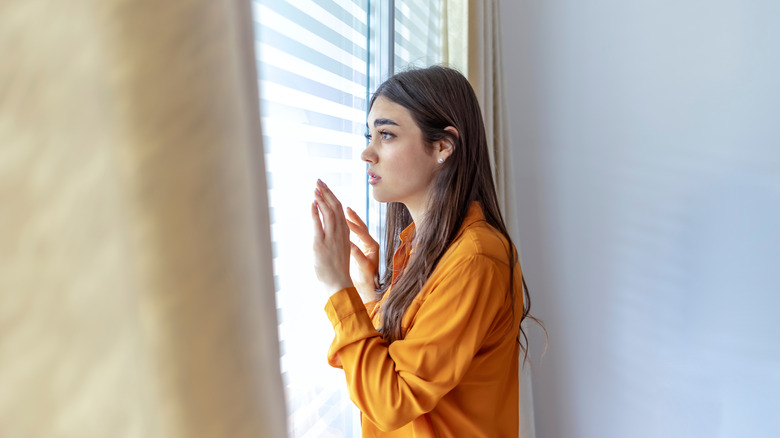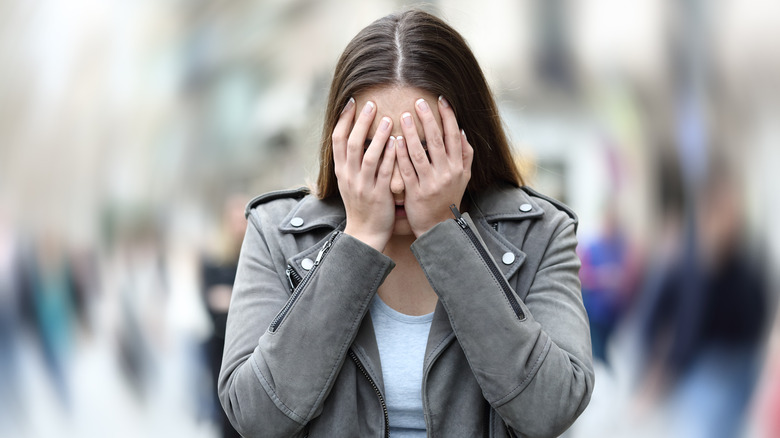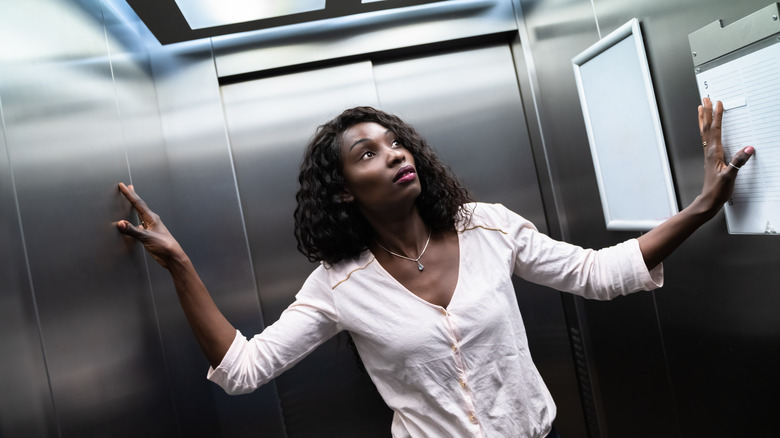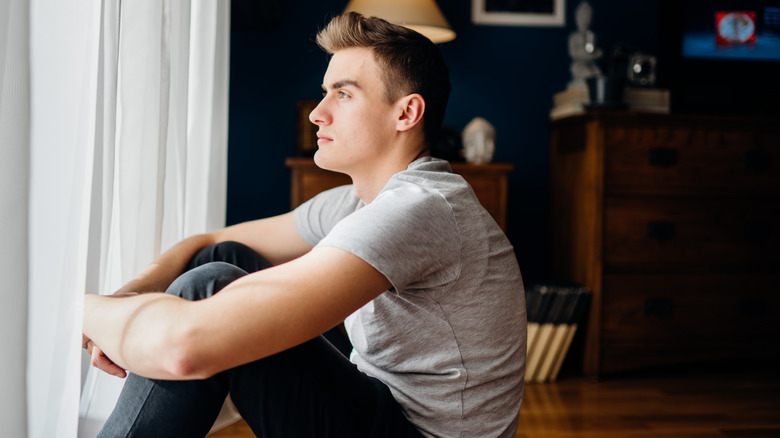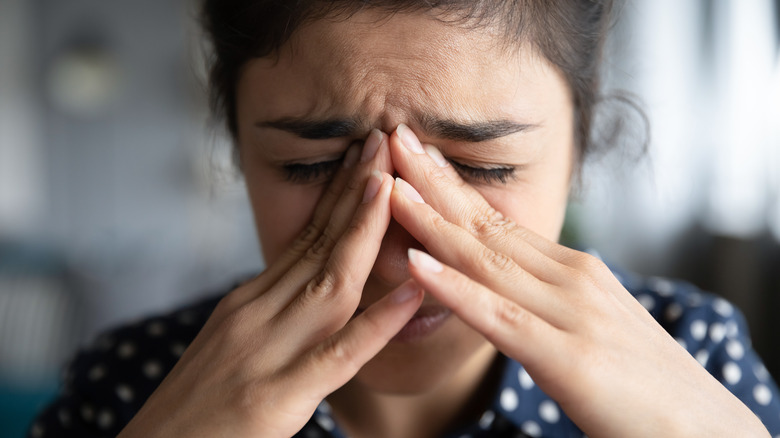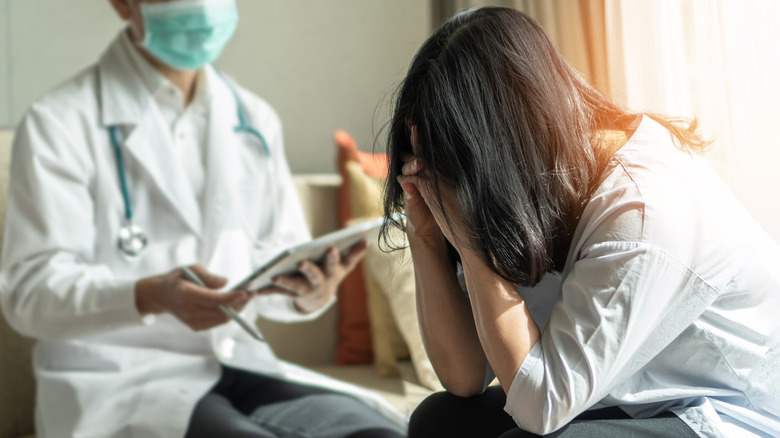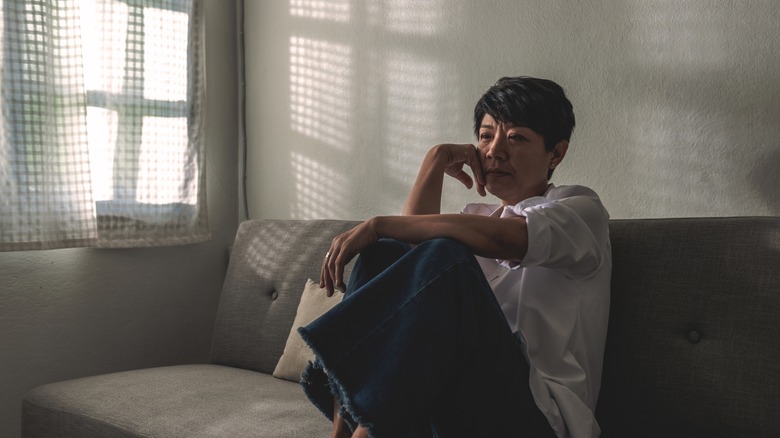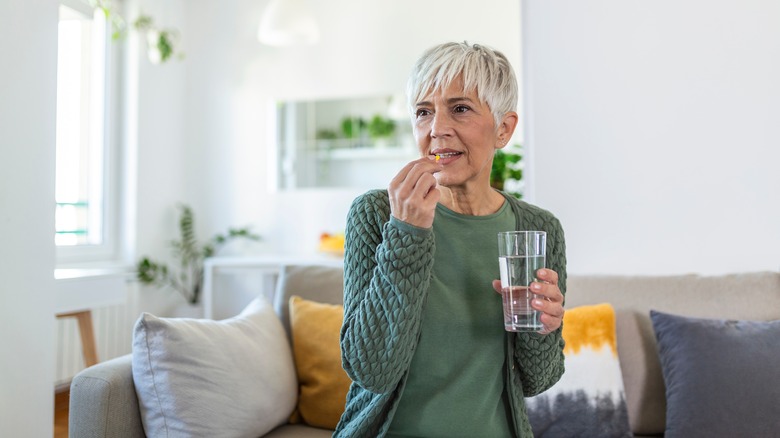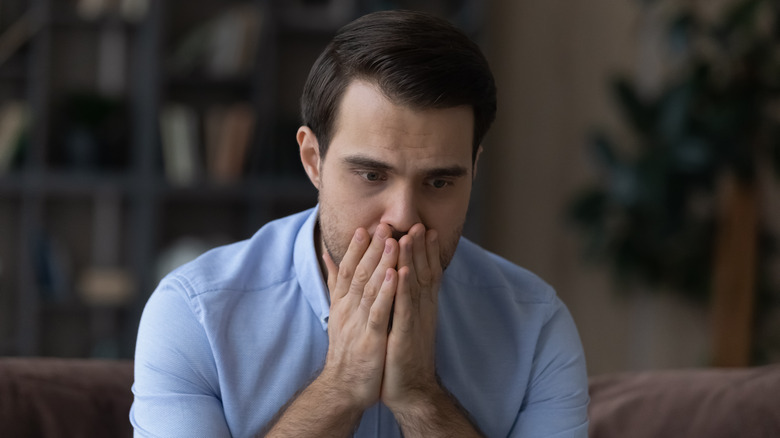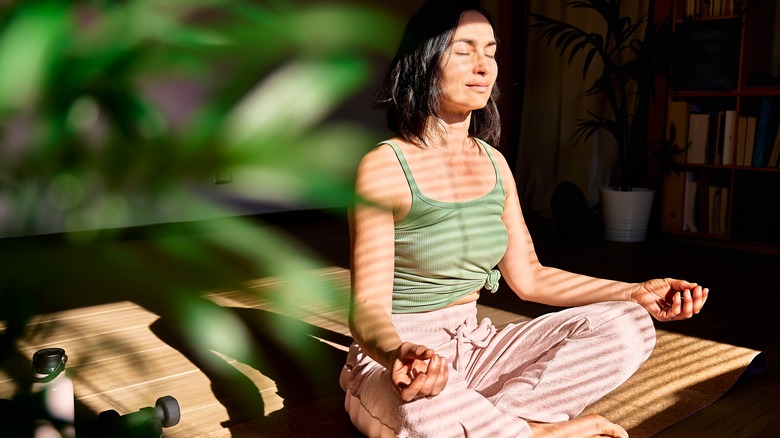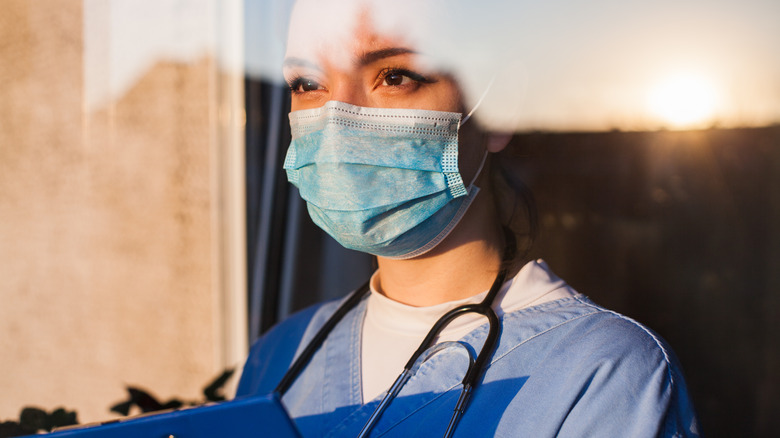Agoraphobia Explained: Causes, Symptoms, And Treatments
Agoraphobia is a rare type of anxiety disorder (via National Institute of Mental Health). In the U.S., it's estimated to affect around 1.3% of the adult population at some point in their lives. The COVID-19 pandemic has fueled the condition, reports inews, making things worse for those who already struggle with anxiety as well as sparking new cases.
Patients with agoraphobia are afraid of situations or environments where they may experience embarrassment or may not be able to escape (via Psychiatry Advisor). As a result, individuals with agoraphobia often confine themselves to a place that they deem safe and familiar, such as their home. Some may believe that the condition is most characterized by avoidance of open spaces, notes the National Health Service (NHS). But in reality, agoraphobia affects people in different ways, setting off different types of fears.
There are a number of effective interventions for agoraphobia, writes The Recovery Village. What's more, it's possible for people to ease their symptoms using effective coping strategies and stress-management relaxation techniques. Just as the symptoms of the disorder vary between individuals, each person may respond differently to treatment. Here are some things that we know so far about the symptoms, causes, and treatments for agoraphobia.
Symptoms of agoraphobia
People with agoraphobia are struck by a deep sense of fear and anxiety (via the Mayo Clinic). This usually centers on places or situations where they may feel stuck or experience shame and embarrassment. Patients often worry that they won't be able to access or receive support if something were to go wrong.
When faced with a sudden bout of anxiety, a person with agoraphobia may experience panic-like symptoms. This can include a racing heart, chest pain, trembling, dizziness, hyperventilating, or sweating. Some people feel nauseated and have an upset stomach, while others may faint or depersonalize (via the DSM-5). On the more severe end of the spectrum, some people think that they could die or worry that they might be going crazy.
The trepidation that comes along with agoraphobia can feel overwhelming, details the Mayo Clinic, which can set off a full-blown panic attack. The prospect of this happening again is a major fear that often underlies agoraphobia, leading to safety behaviors like avoiding feared situations and staying at home where the individual feels in control. Just like any other mental illness, agoraphobia can vary from mild to severe.
Diagnosing agoraphobia
Agoraphobia is a distinct mental health condition, which often occurs alongside panic disorder (via the DSM-5). Agoraphobia with or without panic disorder are two distinct subtypes of the disorder. A diagnosis of agoraphobia is made if you're anxious or afraid of being in certain situations or places. According to the DSM-5, this fear must apply to two or more situations, including a public, open, or enclosed space, such as a bus or a crowd.
A person with agoraphobia will avoid these situations vehemently and is not able to confront them alone. On the other hand, they may feel terrified to the point of distress or panic each time they are forced to face them. The symptoms of agoraphobia must be present for at least six months, affecting the individual's normal day-to-day functioning.
A healthcare professional may formally diagnose you by carrying out an assessment, notes the Mayo Clinic. This will involve asking questions about your symptoms, their frequency, and severity. The healthcare professional will also check whether you're struggling with any other psychiatric or medical condition that might better explain your presenting symptoms.
Agoraphobic situations
Based on the DSM-5, people with agoraphobia experience a sense of dread or panic in at least two of five specific types of situations. These include public transportation, an open space, an enclosed space, a crowd or queue, or outside of one's home. A common situation that's known to spark fear is leaving home alone, according to a 2021 study published in Middle East Current Psychiatry. Another commonly feared scenario, particularly among children, is being home alone –- which, strangely, isn't cited in the DSM-5. The study noted that previous research had also found that many patients feel anxious about crossing bridges.
Patients often reported feeling scared about being in specific parts of a building, such as the bathroom or elevator, per Middle East Current Psychiatry. They worry that something embarrassing or dangerous might happen to them, for example, they could lose their balance and fall, or they may feel nauseated. Others worry about not being able to find a toilet. There are many more feared situations that people with agoraphobia deal with that do not appear in the DSM-5.
Reframing agoraphobia
Agoraphobia was once understood as being a fear of "large, open spaces," according to Psychiatry Advisor. However, in recent years, the disorder has been described by some experts and clinicians as the "fear of fear." In other words, "the fear is not of the situation per se, such as being in a crowd, but of having a panic attack in that particular situation," C. Alec Pollard, a professor emeritus of family and community medicine at Saint Louis University School of Medicine, told Psychiatry Advisor.
An individual may fear having sex or doing exercise because it triggers the sympathetic nervous system, causing their heart to race and their breathing to speed up, writes U.S. News & World Report. These activities can resemble a panic attack, which may feel terrifying to a person with agoraphobia. "I've had patients who are afraid to get emotionally aroused -– they don't want to get really happy, they don't want to get real sad, they don't want to get angry," Karen Cassiday, a clinical psychologist and president of the Anxiety and Depression Association of America, told U.S. News & World Report.
It's often reported that one of the main fears that people have about going to an unfamiliar place or being home alone is that they will be helpless, notes a study in Middle East Current Psychiatry. People also worry about not being able to escape in case there is an emergency. These ruminations can lead to an irrational fear of solitude, also known as eremophobia.
Some common coexisting conditions
Many patients with agoraphobia also have a diagnosis of panic disorder, writes the NHS. In fact, the condition can sometimes be triggered by the trauma of having a panic attack. Up to 57% of people with agoraphobia experience panic attacks, according to a 2021 study from the journal Middle East Current Psychiatry.
A 2020 study from the journal Medicine found that the symptoms of agoraphobia tend to be worse when co-occurring with panic disorder. Patients with both conditions are more likely to be younger when they first develop panic disorder, struggle with the illnesses for longer, take benzodiazepines for a longer period of time, and have a more severe psychiatric comorbidity than others.
Approximately 87.3% of individuals with agoraphobia will experience another mental illness at some point during their life, writes Psychiatry Advisor. This can range from a specific phobia to social anxiety disorder to generalized anxiety disorder (GAD). Those with a history of past substance use disorder are also at a greater risk of developing an anxiety disorder like agoraphobia, notes a 2013 study published in Psychiatry and Clinical Neurosciences.
The possible causes
It is not clear exactly what causes agoraphobia (via the NHS). The condition is sometimes connected to an existing panic disorder. Having already had a panic attack in a specific situation or place, an individual may dread going to this location again and will protect themselves by developing a pattern of avoidance. However, not everyone with agoraphobia experiences panic attacks.
For some people, a traumatic or stressful event may lie at the root of agoraphobia, notes a 2021 study published in Psychiatry Investigation. For instance, an individual may have experienced a sexual assault, bereavement, or abuse at an early age. They may not have been able to work through and resolve this trauma. Some people report parental overprotectiveness as a contributing factor to their anxiety.
There are many possible triggers that may lead to the onset and development of agoraphobia, according to The Recovery Village. There's evidence that the disorder has a genetic component (via Molecular Psychiatry). Its heritability rate is estimated to be 61%, writes The Recovery Village. Most clinicians and experts concede that the condition is most likely to arise out of a combination of factors.
Individuals at risk
Agoraphobia is more common among women than men, based on the findings of a 2021 study published in Psychiatry Investigation. In fact, the prevalence rate is estimated to be up to three times higher in females than in males. Women are also more likely to restrict themselves to their homes compared to men. The disorder is also usually diagnosed in people in their mid to late twenties. Those who develop it often have a history of panic attacks, past phobias, and night terrors. A previous history of mental health issues is also pretty common, including generalized anxiety disorder (GAD), post-traumatic stress disorder, and depression.
Agoraphobia is highly prevalent among people aged 65 and above, writes The Recovery Village. However, it tends to go underreported and undiagnosed since many older individuals refuse to leave their homes or seek treatment. People with certain personality traits and characteristics are also more likely to develop agoraphobia, states a 2021 study from the journal Anxiety, Stress & Coping. This includes those of a nervous or neurotic nature, and people who are generally more introverted.
Interestingly, some studies have discovered that cigarette smoking may be a risk factor for agoraphobia, though more research is needed to understand the relationship between the two (via Psychiatry Research).
What it's like to recover from agoraphobia
According to the DSM-5, agoraphobia is a "persistent and chronic" illness (via Agoraphobia). However, people can successfully recover from agoraphobia, concedes the Cleveland Clinic. Roughly one third of patients go on to recover, and around 50% of people learn to keep their symptoms under control and lead full and productive lives. It can take some people up to 12 months of talk therapy to recover. However, the recovery journey looks different for each person. For some people, symptoms can subside in just a few months with the right kind of intervention, explains U.S. News & World Report.
The disorder can be harder to treat when symptoms are on the more severe end of spectrum (per Agoraphobia). Patients may also take longer to recover if they're struggling with a co-existing mental health condition like another anxiety disorder or substance use disorder. Nevertheless, even patients with a dual diagnosis of panic disorder and agoraphobia can fully recover over time with treatment, says a 2007 study published Primary Care Companion to the Journal of Clinical Psychiatry.
Psychological therapies for agoraphobia
There are a number of effective treatments for agoraphobia ranging from talk therapy to medication (via The British Journal of Psychiatry). Cognitive behavioral therapy (CBT) and short-term psychodynamic therapy are go-to treatments that have proven to work. The earlier the illness is detected and diagnosed, the higher the chances of a successful treatment outcome (via Agoraphobia).
CBT involves working with a mental healthcare provider to challenge and reframe some of the thoughts that underlie your agoraphobia, writes the NHS. This can help the patient let go of dysfunctional and triggering beliefs and learn to adopt more productive responses and behaviors. Therapists may also use exposure therapy, per U.S. News & World Report. This is a form of CBT that supports the patient as they gradually confront their feared situation and overwhelming emotions in a controlled way. Recovering from agoraphobia can be deeply uncomfortable. For this reason, it can be useful to set realistic and intrinsically motivating goals. Over time, CBT can help you think and feel differently about these situations.
Other effective treatments
Some people with agoraphobia benefit from antidepressants like selective serotonin reuptake inhibitors (SSRIs), particularly those who have a diagnosis of both panic disorder and agoraphobia, writes the Mayo Clinic. While these medications do not necessarily work for everyone, some patients have found them to be effective in alleviating their symptoms (via The BMJ). If a patient is struggling with particularly distressing and disabling symptoms, their doctor may prescribe a sedative like benzodiazepines, notes the Mayo Clinic. These drugs are typically used to treat anxiety and are only suitable for short-term relief since regular users can develop a dependence.
Clinicians may sometimes use a combination of treatments, such as talk therapy and relaxation techniques alongside a course of medication, notes the NHS. Some patients refuse to leave their house or have limited access to resources, which can make it hard for them to receive therapy (via Trials). For this reason, clinicians and researchers are now looking at novel treatment approaches, such as a self-guided digital treatment consisting of both psychoeducation and virtual reality exposure therapy. Mobile and web-based interventions have also been shown to be effective, according to a 2021 study published in the Journal of Medical Internet Research.
How to manage your agoraphobia
Along with seeking treatment, people with agoraphobia can manage and work through their symptoms by making some key lifestyle changes, recommends the Cleveland Clinic. Some simple strategies include following a wholesome diet, avoiding stimulants like nicotine, caffeine, and alcohol, and incorporating some regular exercise into your regime. It can also help to establish a low-stress routine, which is conducive to sustaining feelings of calmness.
Some people have found that they are able to get control over their agoraphobia symptoms with psychoeducation and patience, as per the Anxiety & Depression Association of America (ADAA). Learning a relaxation or breathing exercise can help fend off panic attacks, even before they strike.
For those who are largely homebound, there are a number of online resources that can help with symptoms of anxiety and panic, shares the ADAA. Nowadays, it's relatively easy to find a suitable online therapist too. Nevertheless, it's important for patients to gradually progress towards real-life exposure to feared situations, says the U.S. News & World Report. The catch-22 for people with agoraphobia is that avoidance provides short-term relief, but it also reinforces anxiety and feelings of helplessness by keeping the patient locked in a vicious cycle. The more they avoid going outside, the more terrifying and overwhelming it can feel. On the other hand, confronting their fears can help weaken the associations between those situations and stressful emotions.
An alternative route to treatment
There's evidence that complementary and alternative interventions, such as yoga, can help alleviate anxiety (via Asian Journal of Psychiatry). In some cases, the ancient practice may work better than some medications. A 2014 study published in Frontiers in Psychiatry found that yoga can help treat some of the symptoms of agoraphobia like panic attacks, as well as improve patients' mood and quality of life. Yoga was shown to be effective as a standalone treatment. But it was even more potent when used as an adjunct to conventional treatments such as psychotherapy.
There's evidence that mindfulness-based cognitive therapy (MBCT) can also work wonders in secondary-care settings, reports a 2019 study published in Psychiatry and Clinical Neurosciences. MBCT can reduce anxiety symptoms in patients with panic disorder and agoraphobia, and may even be effective with those who are "treatment resistant" to medication. One possible explanation for why mindfulness-based interventions are so powerful in the treatment of anxiety disorders is that it helps to reduce participants' intolerance to uncertainty, according to a 2021 study from the Journal of Anxiety Disorders. "Mindfulness training fosters an open and accepting stance towards all aspects of experience," states the study authors. As a result, fearful experiences might be perceived as less threatening.
The impact of COVID-19 on agoraphobia
The COVID-19 pandemic has been hard on people with mental health disorders, points out a 2020 study from the Asian Journal of Psychiatry. For those with existing agoraphobia, it has heightened feelings of stress and exacerbated their symptoms. The fear of public spaces, in particular, has shot up. Researchers have coined the term "coronaphobia" to allude to the rapid rise in anxiety about catching COVID-19.
Coronaphobia can mimic some of the symptoms of agoraphobia such as heart palpitations, trouble breathing, and difficulty sleeping. It involves some of the same cognitions, such as the fear of leaving the house, and safety behaviors like actively avoiding feared situations. Patients are particularly anxious about visiting crowded locations, where they are more likely to be infected. Some worry that they may contract the virus and die, or that it could affect their ability to work or put their loved ones in danger. While trepidation about getting sick is a normal response to a pandemic, people exhibiting coronaphobia experience an intense fear that is out of proportion to the actual threat that they face.
The pandemic has taken a harsh toll on anxious folks, who may have already harbored these types of fears to begin with, details the Newport Institute. But it's also caused many people to develop this type of paranoia for the first time, referred to by some as "pandemic agoraphobia."

